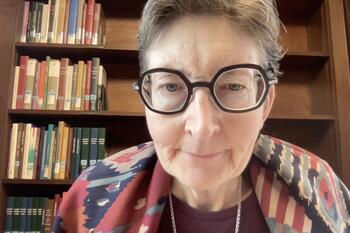Each year the ISM’s short-term fellows’ program brings several scholars to New Haven to work in the Yale collections. These fellows are both senior scholars and Ph.D. students working on interdisciplinary projects in sacred music, worship, and the arts. We posed three questions to one of our current short-term fellows, Dr. Barbara Crostini, who is working on a book project titled, City of Stars: The Dura Europos Synagogue as Performative Space.
 Could you tell us about your research project and the specific collections at Yale that you are working in.
Could you tell us about your research project and the specific collections at Yale that you are working in.
My research project is about the ancient city of Dura Europos on the Euphrates between c. 200 and 250 CE. The Syrian town was then part of the Roman Empire and a large garrison of soldiers lived there. The earliest excavations at this site in the 1930s were conducted by Yale University in collaboration with the French Academy. Funding for the archaeological dig came from American sources such as the Rockefeller Foundation. The finds were divided between Yale, Paris and Damascus. The Yale University Art Gallery has an exhibition space about Dura open to the public, but a lot of material from the original excavations is also stored in the West Campus facility and is available only to researchers by appointment with the curators. I came to make use of this untapped source of material that has only been partly published in scholarly reports. In my book, I want to integrate these new artefacts into a coherent story about Dura Europos as a theatrical city, where different forms of entertainment were devised for citizens and visitors alike.
Why was the ISM and Yale the right place for you to undertake this research?
With its emphasis on music and performance studies, the ISM offers a special environment for my approach to the city of Dura Europos as a theatrical city. For this reason, besides the archaeological collection held at Yale, I chose to apply for a fellowship offered at the ISM. I have found a welcoming community of scholars and have greatly benefited from the fellows’ lunch-time lectures that have provided methodological and comparative inspiration for my own research.
What is one surprising object or discovery that you have made during your work in the Yale collections?
During my visits to West Campus, I was looking through boxes and boxes of bronze objects filed in small plastic bags and kept in large drawers. This long operation seemed at first a rather hopeless task. Many pieces were just fragments. Among these broken pieces were some bronze leaves as large as the palm of a hand, with holes. I wondered what objects these leaves belonged to originally. One explanation was that they protected the flame behind bronze lanterns, so that these could be held without burning one’s hand. However, in looking at comparable finds from other sites of the Roman Empire, I saw these same types of leaves attached to statuettes of the goddess Fortuna, or Tyche, which from other artefacts we know , were popular at Dura. The leaves act as a kind of support and exhibit holes so that the Tyche statuettes can be attached to wooden supports as decorations on furniture. From this discovery, I could envision a whole world of decorated objects that I have not previously imagined. These small bronze finds further unlock for me the environment where actors and actresses moved in the purpose-built stepped rooms annexed to temples. They greatly enlarged my vision of Dura Europos as a “City of Stars.” That is the title of my book.
Learn more about the ISM fellows’ progam here.